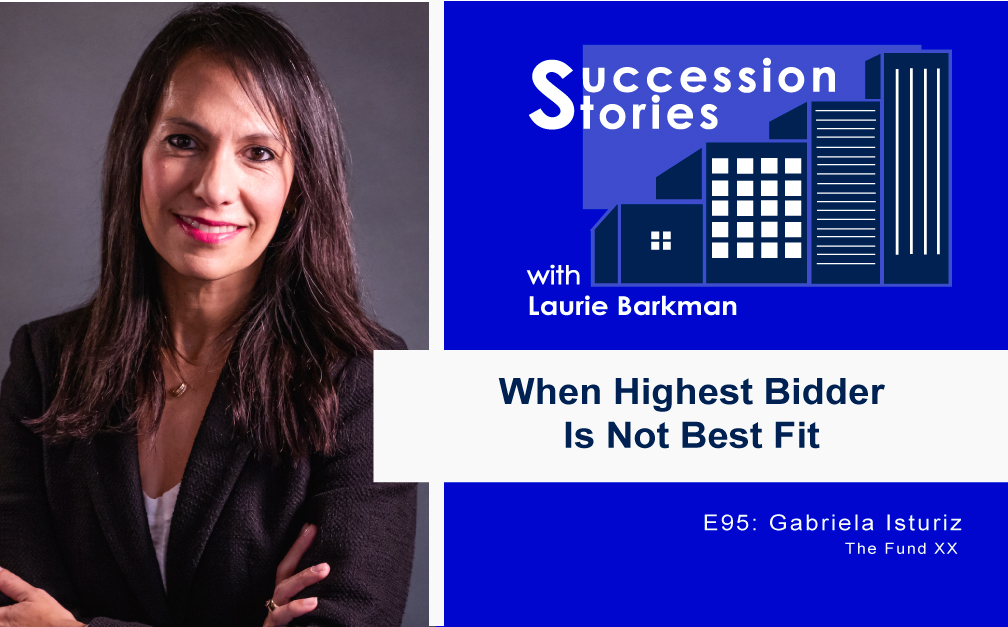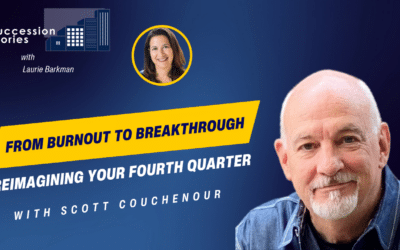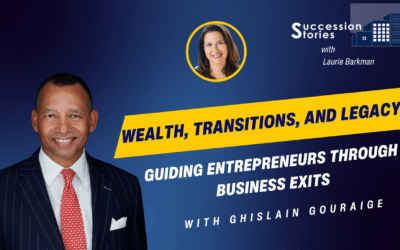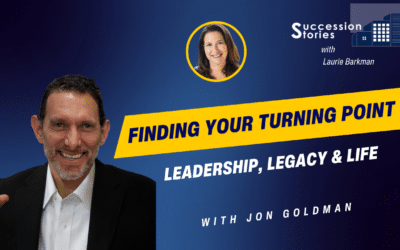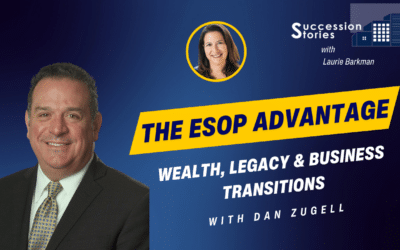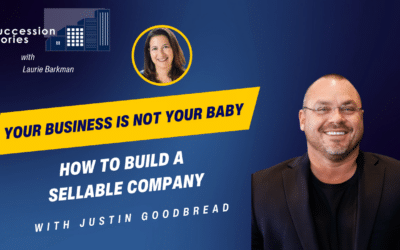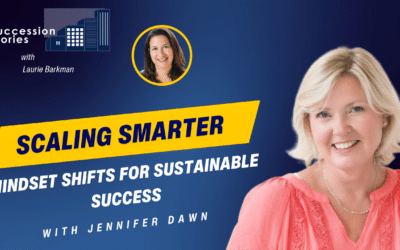Gabriela Isturiz is a tech entrepreneur who bootstrapped two SaaS businesses that were successfully sold to Fortune 500 companies. Gaby pursued innovation in a mature industry and found a market niche in legal tech. She shares the M&A bid process used to generate multiple offers, and why the highest bidder is not always the best buyer for your company. Recently Gaby started a venture capital fund, The Fund XX, investing in the next generation of women-led startups.
Listen in to learn more about:
- How to make your business an acquisition target
- Protecting yourself and your business
- Gaining a competitive edge
- Increasing market share by playing to your strengths
Show Links:
https://www.linkedin.com/in/gabrielaisturiz/
Don’t leave your exit to chance.
Stony Hill Advisors works with owners like you to get ready and maximize value when you’re ready to sell.
Visit www.stonyhilladvisors.com/podcast for a complimentary business valuation.
About Succession Stories Podcast
Succession Stories is an award-winning podcast hosted by Laurie Barkman, the Business Transition Sherpa– guiding business owners through the process from “transition to transaction.”
Learn more at https://thebusinesstransitionsherpa.com
Book a 1:1 Advisory call at:
We appreciate your support…subscribe, share, and post a review to share what you like about the show!
Transcript
Laurie Barkman:
Welcome to Succession Stories! I’m Laurie Barkman. As an exit value planning and M&A advisor, I call myself The Business Transition Sherpa. This podcast guides entrepreneurs from transition to transaction- from building value in your business to letting go.
What do I do when I’m not hosting a podcast? I work with owners to maximize business value with my firm, SmallDotBig. And as a Certified Mergers and Acquisitions Advisor with Stony Hill, I guide you through the complex process of selling your company.
Tune-in to Succession Stories for weekly insights to reward your hard work and avoid succession regrets. Hit subscribe wherever you listen to podcasts, and sign-up for our newsletter at successionstories.com. Here’s to your success!
Is this the year to sell your company? Don’t leave your exit to chance. Stony Hill Advisors works with entrepreneurs like you to get ready for what may be the biggest transaction of your life. Learn what your business is worth by visiting stonyhilladvisors.com/podcast.
Intro:
Gabriela Isturiz is a tech entrepreneur who sold two SaaS businesses to Fortune 500 companies. Gaby is one of the few women in STEM who has led bootstrapped companies to successful exits.
She was the founder and President of eBillingHub, pioneer of electronic billing for law firms worldwide, and sold the company to Thomson Reuters in 2011. Just eight years later, Gaby sold her second tech company, Bellefield Systems in 2019. After her last exit, Gaby launched The Fund XX, a venture fund investing in the next generation of women-led startups.
I enjoyed my conversation with Gaby for many reasons. It’s an impressive entrepreneurial story that hits on the core themes of this show: innovation, growth and transition. We discussed how to find a market niche by solving customer pain points and innovating in a mature industry. We also talked about running an M&A bid process to generate multiple offers. Listen in to hear why the highest bidder is not always the best buyer for your company. Enjoy this episode with my guest Gaby Istruriz.
Laurie Barkman:
Gabriela Isturiz it is so lovely to have you on the show today. Welcome to Succession Stories.
Gabriela Isturiz:
Thank you for having me, Laurie, I was looking forward to being with you today.
Laurie Barkman:
We’re both in Pittsburgh, Pennsylvania. That’s how we met and I feel so fortunate to have met you recently at a conference and when we were talking, it became very clear to me how impressive and successful you have been in your career, and you’re doing some very exciting things now that you are an investor. You’re a successful entrepreneur. I want to mention for the audience, you’re one of the few women in STEM who has not only bootstrapped her company to a successful exit, you’ve done that twice and that is amazing. I can’t wait to hear your story. Why don’t we dive in with your first company, which was called eBillingHub, and I think this is a super interesting story, because you innovated in a space – legal – right, that was very mature and is a very mature industry, very well established but this is an innovation story for legal tech. Your first firm was eBillingHub. Can you give me the background? I’m so curious to learn more.
Gabriela Isturiz:
Yes, absolutely. A little bit of my background, Laurie, and I like to say I’m originally from Venezuela, Caracas, and I think I always say the same, but I think it’s funny, I came to the United States for two years, 26 years ago, I never left. I had the opportunity to go to the University of Pittsburgh, to do my master’s degree in information science, and then I was hired by a large law firm, one of the largest law firms in insurance, defense and insurance defense is well known by the amount of cases we’re talking about, pretty much 20 years ago, in they have this need this new thing. Electronic billing was a new thing. Basically, law firms needed to submit order invoices through a channel. Imagine like an EDI, but for law firms, and with some sort of parameters and rules to get the bills, not in paper, but in electronic format so it was very nascent of a concept. Part of the reason why they hired me is because, at the time, they had 1000s, and 1000s of bills that needed to go electronically, that someone was typing by hand to in an electronic format so I looked at the amount of research Laurie, and I couldn’t find anything in my background. I’m a software engineer, and just by the fact that you can write code, I call it you get some superpowers, so I develop the solution.
A little bit of my background, even though I’m a software engineer, my specialty was in building in house solutions. So I built this great solution for the law firm. Adding a lot of value in I always had this entrepreneur in me since I was little, so I said there is a commercial – there’s a huge opportunity here that we need to go after, so I went to my boss, an amazing person and amazing lawyer, he passed away and he was one of my greatest mentors. He said, “Gabby, absolutely you can do these commercially as long as you don’t leave the firm. Do your thing, and we want to retain you.” I was at the front for 10 years so that speaks a little bit of the bond that we had and the amazing place they were to work for. We agreed that I could do something commercial but then there was a lot of trust but I don’t think, to your point of innovation, I don’t think they saw this as a real opportunity. It was a little bit like, “She wants to do these, we cannot afford to lose her. Knock yourself out and have a passion project,” so I didn’t have any kind of legalities around that. Pretty much all the invention was myself, but when things were getting a little bit more serious, I went to my boss and said, “I think we need to do these a little more seriously.” They said, “Give us a little bit of a percentage.” “Whatever, it’s fine,” so they let me continue doing the company, Laurie, and I met – in grad school – I met my business partner, who came to be my husband of 20 years. He was a software engineer, he knew how to build commercial software so we partnered, “We’re going to build commercial software. We’re going to take these,” and my boss said, “Yes, that’s fine.” A little bit of that. I continued to work for the firm, and Danny left his job at the University of Pittsburgh and that’s how we started.
Laurie Barkman:
That is incredible. I have to rewind on just a few things to just underscore. I’ve worked in a law firm for a few years, and I understand the dynamics, there’s a lot of paper, right? Especially if this is – what year was this?
Gabriela Isturiz:
2000-2002.
Laurie Barkman:
2002, so we have to put ourselves back in time, there’s a lot of paper moving, there’s a lot of dollars at stake. What you did was, you identified some pain points, if we look at the market need, you had a captive audience for a pilot, you found product market fit in the law firm, you knew that there was pain, you knew that there was value and then you created a product that – how many lawyers – roughly 100 plus?
Gabriela Isturiz:
Yeah, probably 150-200.
Laurie Barkman:
You could develop this product, commercialize the product right within the law firm, prove it out, and then you are given the latitude to go commercialize the software platform. That’s amazing. I admire not only the law firms, I guess, willingness to support that for they found it effective internally, and they used it, but then also to give you that latitude to run with it, and that took a lot of time. I mean, how did you, Gaby, how did you do that? You were managing a startup as well as maintaining your role at the law firm?
Gabriela Isturiz:
Yes. Totally. I was so passionate about solving this problem, building this company, and very passionate about the challenges that I had at the law firm. I didn’t feel it was a chore. I was doing what I love to do and I think when you’re doing what you love, it’s like, you know that saying that you’re not working? I felt that way and even fast forward 20 years or more, I didn’t feel like I was working. I was just having fun.
Laurie Barkman:
That’s incredible, so when you spun it out, and at some point, you found it was time to sell, how did you know when it was time to sell, and what were some of the deal dynamics? I think it sold to a strategic buyer. I don’t know if you ended up talking to financial buyers as well but maybe you could just share a little bit about that. Play that time frame and what was happening.
Gabriela Isturiz:
Yeah, it was a very interesting process. We were super young, this is 20 something years ago, and it ended up being done. One of the partners of the law firm saw the opportunity and for a little tiny piece bought the interests of the law firm so the law firm went away and we had a partner that was retiring. We were super excited to open these many opportunities, but our interests were not aligned. We were building something revolutionary, this was back in 2000-2002. The worst SaaS was not even invented yet. Remember that in 1999,2000 Salesforce were the first SaaS so we were calling our solution Application Service Providers. We were the first SaaS for law firms. There was already SaaS for the civilian vendors getting the bills but we were the first one. We knew this, I said the amount of the opportunity, he was pretty much retiring, we were starting pretty much our entrepreneurial journey and we grew once had a fine, decent market fit in Canada. Let me make a parenthesis. It took us about three to four years to make our 41st customers and then after we partnered with Thomson Reuters and there’s some drama there, we got our next 100 customers in a year. Totally a hockey stick. We started generating a lot of revenue. We were already very, very profitable and so our interests were not aligned. We wanted to keep it going and pretty much we sold too early in my view, but it was a great journey. We learned a lot.
Laurie Barkman:
It sold to a division of Thomson Reuters. Is that correct?
Gabriela Isturiz:
It was Thomson Reuters Legal.
Laurie Barkman:
Okay, so we should probably just share it, and then Thomson Reuters in the legal space is the 800 pound gorilla. They are dominant, and they have a lot of great software that law firms use and you had a partnership with them. Was that a strategic move? Did you envision at some point that they might be the acquirer because of that partnership?
Gabriela Isturiz:
Yes, Laurie, a bit. Let me tell you a little bit about the journey to get there because it sounds very romantic. We did a partnership. They were interested and they borrowed a little bit of, we knew that we have something incredibly innovative, so I went to talk to the CIO of Thomson Reuters Legal to look for a partnership and he was so impressed with that. I pretty much – very naive – I spilled all the secret sauce. You could see that they did not figure this problem out the way we did and so he said, “Yeah, Gaby, it’s incredible what you’re doing. I would love to partner with you.” We were incredibly static. Hey, this 800 pound gorilla is partnering with the little guys. Then they went silent, Laurie. It was two weeks. They don’t respond. Three weeks. They don’t respond so I continue my outreach, my outbound and nothing happens. The next thing that we knew, is when I saw a press release, they had launched a competitive product.
Laurie Barkman:
Oh, wow. That is so incredible. We hear about that. We hear it. It’s like the mythical unicorn animal, and you hear this story and now, wow, you actually encounter that because I say to people, what matters the most is the conversation, not necessarily when you’re in the room, but when you leave the room. They’re trying to figure out if they could replicate what you do.
Gabriela Isturiz:
That’s exactly what it is. If they can figure it out, we can too. It’s kind of like a playbook, Laurie. They’re gonna try because of course, they have pretty much unlimited resources and they have pretty much unlimited access to great talent. “How are we going to do it?” What happened was I was devastated. Totally devastated, so my business partner, Danny said, “You know what, Gaby, this is great. It is great. Because if they’re able to try to copy what we’re doing, that’s proof that they know how to do this, right? So what we need to do is we’re going to beat them in the market, because the playbook is they’re going to try to do it. You start taking customers. They don’t do it as nimble or as innovative the way you can do it and the reason is, we make decisions faster. We’re only focused on solving problems, while they have this many departments and these many products, and so we have an unfair advantage.” We knew Laurie, that it was impossible for them to do something better than ours with all their resources because we were thinking how to fix this problem, day in and day out, so we said, “Okay, we’re gonna beat them in the market,” and that’s what happened. They paralyze the market because when they announce it, we go… it’s like that saying, nobody got fired for buying from IBM. We have our early adopters, people that understood that they couldn’t innovate the way we did. We started getting our lighthouse accounts and the ones we got, another 40 out of their portfolio, their solution wasn’t selling as great as it was, so they said, “Let’s call her.”
Laurie Barkman:
How much time did it take for them to launch?
Gabriela Isturiz:
About six to eight months.
Laurie Barkman:
In that time, it was also probably good marketing for your company because they were validating that this was a worthy service and you were already established in the market?
Gabriela Isturiz:
Yes. It was more mature. We had a library of evolution templates, and so yeah, but it’s a playbook. They’re gonna try to do it, you beat them in the market, because now we earned the place to partner with them because there was no risk. The product was already in one of the largest law firms in the world and so we did an OEM with not only once we came with Thomson Reuters, right after some other practice management system came out came along so we have these incredible relationships, not with Thomson but with the others and what happened was, it opened the doors to really scale this. It really worked because even though they said, “We’re going to sell your product,” and probably this is something for the audience, so when you go into a reseller, or an OEM, both, it’s great on the ability to open doors, but nobody’s going to sell your product, nobody is going to carry the message the way you do. They were kind of like a broker. Once they generated the leads within the law firms, we’d call and go in to sell. We needed to give a high percentage typically to these resellers and OEMs. We had a sales force to deploy, to maximize the success rate.
Laurie Barkman:
It was a lead generation arrangement, because they were cross selling, and then they got a percent of the sale but your sales team were the ones who would close?
Gabriela Isturiz:
Yeah, and do the demos and everything.
Laurie Barkman:
Gotcha. That’s important. Did you have to spell all of that out in the partnership agreement?
Gabriela Isturiz:
No, we kind of learned that along the way and the biggest lesson, so when you do these with sellers, their sales force have a bag of products, and your product is wanting the bag right, so how do you differentiate yourself? I became an advocate in support of their sales force, basically.
Laurie Barkman:
What does that mean?
Gabriela Isturiz:
For example, we will provide all the messaging, all the marketing material and we try to control the sales process. We had a team just to do the demos for them so they didn’t have to learn it and we were very passionate, which is hard to convey so we made the most out of the relationship, and worked so well that we replicated the same with the other OEMs and partnerships that we did.
Laurie Barkman:
So it wasn’t exclusive?
Gabriela Isturiz:
It wasn’t exclusive.
Laurie Barkman:
Okay. That’s also important. At what point, you mentioned earlier you had another owner of the business, so it was yourself, your partner, your husband, and then there was another individual who influenced the sale.
Gabriela Isturiz:
Yes.
Laurie Barkman:
Can you talk about that dynamic? Because I think that that’s pretty interesting. What was that like? Can you go a little bit deeper?
Gabriela Isturiz:
Again, we learned a lot. One of the things that we learned… we were so excited at doing this partnership with a partner. A partner that didn’t go deep into the legalities of the arrangement. Our legal structure and our legal arrangement was very, very loose in that we were not savvy enough in terms of valuations and all that. It’d be, “What’s the salary of a litigation lawyer?” He had an advantage in negotiating to their favor. We pretty much were forced to sell it because of the lack of legal structure to protect us.
Laurie Barkman:
Interesting and so the lesson learned there for a founder who wants to bring on an investor would be to really make sure that they have an attorney who is thinking through their interests.
Gabriela Isturiz:
Yeah. He was the one that we trusted to look for our interest and we were naive, so yeah, you gotta have someone that is going to look for your interest.
Laurie Barkman:
Gotcha. Time to sell. How was that dynamic? How did you decide that you wanted to sell and who to sell to? Did you approach Thomson Reuters and say, “Look, we think we’re a great fit? Are you interested in buying us?” Did you go to Aderant and others as well?
Gabriela Isturiz:
What happened was, because this solution was so unique and we were even surprised that even after 5,6,7 years no one in the industry will come up with a competitive product sothe market was ours. The clients were ours. It became the leading solution in the world so what happened was, Thomson Reuters approached. Pretty much everybody else approaches. To go a little bit more into it, even Wolters Kluwer. We became an acquisition target from the usual suspects, already, so we knew, “Do you know any of these publicly traded companies? We’re gonna be the target in a little bit.” You have the idea to innovate, they’re going to try to do what you’re doing, because why not? You start getting the clients in, they’re gonna buy you. Because they are limited in the ability that they have to innovate. For example, Laurie, by the time that they will have to get a business case approved we already had two versions of the software out, but they gotta, you gotta prove yourself, and then you become an acquisition target and that’s what we did.
Laurie Barkman:
Right. Gotcha. Did you have any outside help at this point? Did you hire an intermediary to help you? You’re still running your company day to day, and this is gonna now take a lot of time or did you run point yourself?
Gabriela Isturiz:
It was a little bit like, the first time around, it was incredibly flattering that you have this many unsolicited offers. In other words, we didn’t think about an investment banker, or anything like that. This is something that we can do. We know a bunch of lawyers. It was very organic and thought out, I would say.
Laurie Barkman:
How long did the process take from when you’re getting the unsolicited offers to actually closing?
Gabriela Isturiz:
It was probably six to nine months.
Laurie Barkman:
Okay. Pretty long process. Can we talk about the deal itself? What were you doing in revenue, roughly, at around that time?
Gabriela Isturiz:
I mean, top line, we were probably about six or seven.
Laurie Barkman:
Okay and it was this 100% SaaS recurring revenue business, so I’m assuming you sold at a multiple of revenue, and you were negotiating multiples of revenue.
Gabriela Isturiz:
Yeah.
Laurie Barkman:
Okay.
Gabriela Isturiz:
Every vertical has their own range based on growth, based on revenue, based on EBITDA and, it’s very consistent across the board in this industry.
Laurie Barkman:
You don’t have to disclose what the multiple was, but sometimes in this industry, it’s 10x, so it can be a pretty sizable number for companies and there’s reasons to be above or below some of those benchmarks of course. What were some of the main dynamics that you found in the negotiation? Did they want you to stay on and have an earn out? Was it that the founders were out at closing? What were some of the things that were important to you or important to them?
Gabriela Isturiz:
The first experience was a very difficult experience. There was litigation involved so part of the deal was, we’re not coming over the transition and because the conditions were, like I said, we were not aligned. We learned a lot but yeah, it was different kind of like opposition, because there was litigation.
Laurie Barkman:
Litigation between your firm and Thomson Reuters?
Gabriela Isturiz:
No, with our partner.
Laurie Barkman:
Oh, excuse me. Gotcha. How did you feel when the day came of the closing? Did you feel excitement? Were you sad? Were you because this is your baby; you had been working with this company, you bootstrapped it with your husband? What were some of the emotions that you were feeling at the time?
Gabriela Isturiz:
It was not good. It was kind of like a sense of loss but I mean, we knew that there is a better opportunity waiting for us, this is our first attempt at this. We did that really well. Let’s take all our learnings into the better, and we do so I think in a way. Laurie I don’t regret any of the experiences other than to have a better legal framework around. Everything else really made us all stronger. We learned a lot that probably otherwise we would have not learned. With our second company, we pretty much engineered a company that we wanted to build an exit and we were very deliberate in how gross margins are going to be, EBITDA, margins, growth, recurrent revenue and every other metric. For example, Laurie, we understood that not every revenue is good revenue so we favor 90% for the recurring and that anything that was not recurring, that was our giveaway, and you can discount – to the salespeople – you can discount the setup fee, but we don’t discount the recurring revenue, because we were evaluated on that so if we did it in about seven years, probably six, seven years, we grew that company to the point that we also became an acquisition target.
Laurie Barkman:
That’s incredible, so this is Bellefield systems now?
Gabriela Isturiz:
Yes.
Laurie Barkman:
You took some a little bit of time off between the two startups, but not much, was about a year or two years.
Gabriela Isturiz:
Yes. It was a year.
Laurie Barkman:
So you weren’t prevented from working in the legal tech space. You weren’t prevented from creating another entity that was going to potentially compete with Thomson Reuters.
Gabriela Isturiz:
We are prevented from creating a very similar solution in that space so we couldn’t create another eBilling or the like.
Laurie Barkman:
Bellefield was timekeeping.
Gabriela Isturiz:
It was timekeeping. It’s very interesting because all lawyers have been keeping time since the 1940s. With the practice they realized and there is some history there was nothing really innovated there so, with the first company, we really created a market that didn’t exist. This one, it was already there, a little bit of that. Normally when you create a market, part of the challenge, what took us a little bit longer is because we needed to educate the market to sell things that they never did. Kind of like using a solution to send bills electronically, as opposed to printing and sending up. They were already used to that. It’s bringing innovation in how they get their time. Our first solution was the iPad. When we came, we started seeing lawyers with it, but we started seeing law firms buying iPads, and they didn’t know what to do with that. There were no apps for iPads for legal use so they could be used like Notability, and they could use their email. We said, “There is a huge opportunity. Let’s do only timekeeping for iPads. That’s it.” That’s how it started. Then hey, “Can you do it for the iPhone?” “Yeah, I think we can,” and then, “How about Android?” The vision always was, we want to own the lawyer experience, when it comes for them to recover in time and we built a whole company and started an anywhere mobile solution. Then we became a desktop solution anywhere and then we put compliance into that. We knew that we wanted to get the market out of immobility and ride the wave of Apple in innovation. We knew that there was a very great vision behind it in a much bigger game so the compliance came about. They could enter, let’s say, an entry, a time entry, and immediately, it was going to be validated. The client is not going to pay for this so immediately we have the intelligence and the knowledge to make sure that everything that you put in was compliant and we can have pioneer data as well.
Laurie Barkman:
That’s awesome. Many times we hear about tech that is tech first and then it tries to solve a pain point. You understood the market really well. You understand the law, the lawyers’ workflow, and where they had ups and downs in their day, and no one enjoys timekeeping, let’s face it, but it was the way we always do it. You found a pain point you had market need and you saw the opportunity to build and differentiate, which is really incredible. In this space, you were able to do it twice, one around the electronic billing, and one around the timekeeping. What’s fascinating also, because I did spend a little bit of time, not as many years as you, but I did spend a couple years in a law firm and lawyers are not really known for being super tech savvy. Now, of course, there are lots of people who are so I’m not trying to generalize too much but if we put ourselves back into this time period, also, not typically early adopters of tech. Did you find that the training was something that you had to think about for the users and their use cases? Or was it just so easy to use and pick up that the lawyers just ran with it?
Gabriela Isturiz:
I love this question because I mean, it brings my passion. Something that we learn by being kind of like insiders, it’s our lawyers are incredibly smart, incredibly skilled, because they speak for a living, they make deals for living, Because of that, or why I always challenge our lawyers and accountants because I mean, we also had accountants are using our solution, they are not averse to technology, they just averse to technology that is not easy to use. Our only thing is, how can we make this incredibly simple for them? That’s how we grew so quickly. In 12 months we were already profitable. We already had like, I mean, 500 law firms in two years. It was because it was so simple, not only for the lawyer to use, but so simple to deploy, that a large law firm of 500 lawyers, they could be up and running in a day and a half, which was also part of our mantra, how we can remove resistance from the lawyers o adopt the technology, and from the IT and operations department to implement it.
Laurie Barkman:
Makes a lot of sense. Similar story here, because this company, the difference was you said you were building it to sell from the beginning so there was probably a little less of an emotional attachment to Bellefield. Then there was your first company, I’m guessing but here are you in this situation? I think I heard you in an interview where you went on another show and you talked about, I think it was the Built to Sell show that you did with John Warrillow. You talked about hiring an advisor and so now this is your second time around, you’ve been through it. Why didn’t you say, “Oh, we can do this ourselves again?”
Gabriela Isturiz:
That’s an excellent question. In 2018, which was one year prior to the sale, we got three or four unsolicited offers, term sheets and all that. The company was a little bigger. There was a lot of stake in the end, even though we were flattered so we could decide, “Okay, let’s entertain, let’s look at that. Well, let’s have some meetings, then we realized there is too much complexity here. I was super focused on making our revenue goals, growing the company, and that we say, “Okay, I’m not ready to entertain any of these.” In 2019, because we were growing a lot, I decided to get an investment banker to help us into an equity growth round. We weren’t even thinking about selling the 100% yet. Part of the strategy was, we have a lot of time, and energy and everything invested in here, that is wise to take some chips off the table. There was a lot of appetite from private equity to do that, and we cannot meet every private equity that invests in SaaS so we have the growth, we have the revenue, we have the EBITDA. We had this magic number that anybody can go up but it was basically the ratio between revenue and marketing and sales. We became very, very attracted to private equity but because we knew their potential, we said, “Okay, so let’s go ahead and shop around and let’s find the best deal.” I believe, Laurie, that without our advisors, our strategic advisors, and our investment banker, we never would have done the deal that we did.
Laurie Barkman:
You ended up selling the whole company.
Gabriela Isturiz:
We ended up selling, so I cannot treasure enough the value that our strategic team and our investment banker brought to the table, and they earned every penny.
Laurie Barkman:
That’s amazing. Did you go into this with an expectation of annual recurring revenue multiple? I know I said 10x earlier, and that’s probably much higher, given your first company and the time period so I’m guessing that that’s not a number we want to anchor to but in this scenario, was it somewhere around that neighborhood? Was it less than that, that you thought you would sell for?
Gabriela Isturiz:
We knew the number because we knew the market, we already had prior experience so what happened was we closed the deal in 45 days. That’s with Thanksgiving in between. Couple of things to say to that. I was extremely diligent and organized. Everything was by the book, Laurie in terms of there was nothing obscure. There are no secondary sets of books. There are no messy operations so it was a very well oiled machine. The investment bankers didn’t have to deal with okay, there is no contract here. The company…there is no proper incorporation here so they came in, it took us about a month and a half or two to get the story together, to get the books together and once they had the books together, they were very, very effective in identifying potential partners. Remember, with the first round, we got about 60 NDAs and then we started narrowing it down. We ended up with 12 offers that were worth considering. Our investment banker in Atlanta, he created a very honest bidding situation. It’s one of the things that I was most impressed by. He will never influence my decision. He just presented the facts. He never took any side but he educated me to make an association. I think he was a great investment banker and it shows because his job was supporting our organization not making a decision for us.
Laurie Barkman:
Yes, and by having a bidding process, you were probably able to get them to play against off each other in a way that, as you said, it was it was honest, there’s no…that’s part of the process, when you have kind of an auction, let’s call it, where these different companies are interested in you and they’re interested in getting a deal once, and it’s a negotiation so there’s always that room to, perhaps for them to raise their prices and, get to a point where you say yes, so I’m guessing that that worked out pretty well for you?
Gabriela Isturiz:
That’s a little bit of what happened. We do that by getting the company with these KPIs. We knew the number but thanks to the competitive situation we were blown away by the final offers. That’s great. Again, I’m super passionate, I cannot go through this again, because we were extremely lucky so then we took these 12 offers to four, and then 2,3. One of them was on a strategic buyer, the two of them, it was incredible private equity that I have very dear to my heart. Then because you develop a bond with them you have an honest relationship with them that it becomes extremely hard to make a decision. There was no wrong decision. Each one will add enormous value on their way. My husband and partner supported me to make the decision. I went to my advisors, I went to my executive coach, just to get a little bit of advice and in part of my decision making framework, all these are amazing. Private equity is amazing. Companies. There is a way but how do I feel that my employees are going to thrive? I had a female CEO that I really respect and treasure. I think there was so much respect and trust I knew that I wanted them to be my home.
Laurie Barkman:
It wasn’t only about the highest bidder.
Gabriela Isturiz:
In the end, we didn’t take the highest.
Laurie Barkman:
Super interesting. I’ve heard that as well so I’ll say it again, like this mythical thing you hear about and here we are that that was your situation. That’s fascinating. The culture of the company, the prior relationship, the fit for your employees, you and your husband decided to probably not stay on, I’m guessing, but you wanted your team to have a sustainable future with this entity and so it was Adam and Rper.
Gabriela Isturiz:
Yes and not only that, our values were absolutely aligned. Laurie, very different from our first experience so when we came into the negotiation, our LOI, and probably you’re familiar because you’ve done this many, many times, we were all for a win win. There were no shenanigans. There was no hidden…Every day, we would come into reviewing documents, and everybody was putting their best so we wanted to succeed. There was no chance in our mind that this deal was not going to go forward. That was not an option, so we have to overcome some hurdles but having the desire to really succeed at this transaction made it super easy and as a result we closed the deal in 45 days.
Laurie Barkman:
That’s amazing and around Thanksgiving. That’s just incredible, highly, highly motivated buyers and kudos to you and your team for really being ready. That speaks volumes to the process because the more ready we are for a transition, the more options we’re going to create. Your story 100% illustrates that point. I want to jump to what you’re doing today because it fuels your passion and mission in a different direction. After you sold, you probably took a little bit like a week off right now. Kidding. You took some time off, hopefully to enjoy. Did you do some travel?
Gabriela Isturiz:
Oh, well, because Tony and I were grinding for 20 years, we decided to go to Europe for six months and we were set to go March 10 of 2020 and the next day it was a lockdown so we couldn’t go.
Laurie Barkman:
You had a staycation like the rest of us.
Gabriela Isturiz:
I had no job because we already completed the transition from December to March so I was pretty much in my house with my kids and pretty much without anything that I knew and loved to do. I was not doing any of that.
Laurie Barkman:
Yeah, that was a tough time. It was a really tough time.
Gabriela Isturiz:
Super bittersweet. A little bit like the serendipity of life. Someone knew that I was available and they said, “Well, you’re a female founder, you’re a minority founder, talk to Gabby, right? She just sold her company,” and all of a sudden I was advising a company’s amazing founders, amazing female founders. I started angel investing in them because I believe in some founders, so much that it led me to be part of our fund and become an FP of one fun as I was doing the advising, and then through these, I have the opportunity to start my own fund but it was kind of like a non plan, right, It just happened.
Laurie Barkman:
Very organic. They started reaching out, and interesting, too, because as I said in your introduction, you bootstrapped your first two companies, you didn’t have experience with venture capitalists, they weren’t on your board and now you are a VC and it’s an interesting juxtaposition because now you’re looking to support women in an industry at the field of venture capital, where the percentages are pretty low, aren’t they, for VC investments going to women founders, it’s like 2%, or something, really low number.
Gabriela Isturiz:
Yes, it’s very sad. Less than 12% are female making decisions on investments so there’s a long way to go but yeah, that’s why I love what I’m doing.
Laurie Barkman:
The name of the fund is The Fund XX, there’s a little bit of controversy about the name, I understand, but let’s talk about that – the positioning of the fund and how you support women investors, and if we, as listeners are hearing this, and they’re thinking about, Oh, I know someone that might be a fit for talking with you or connecting with you. Maybe give us a sense of the types of investors that the fund looks to support.
Gabriela Isturiz:
In terms of investors, we are incredibly proud to say that 90% of our investors are female, and even some very qualified people that didn’t have the chance to be part of a venture fund before so in a way we’re trying to democratize the investment and be part of the VC investors community. I think we’re doing something that few others have done, we share the same philosophy and they were also very successful in having female investors. On the investment side, as we deploy capital to our founders, our investment thesis is we want to support the next generation of female leaders xo we only invest in companies where the CEO is a female. We decided to draw a line on the sand because we want to support the leaders. Then we participate in rounds that are between half a million dollars and a million and a half because we invest in pre seed and seed rounds are only in the end and lastly, we look at the founders knowing, do they have the DNA? Do they have the domain knowledge, and, I like to say, the integrity that we want to support. In addition to that because we all come from technology, we invest in tech, enable companies that we believe are right, that can provide the returns that our fund seeks out.
Laurie Barkman:
Excellent. This is the US only?
Gabriela Isturiz:
For now it’s US only.
Laurie Barkman:
Okay, gotcha. Well, that’s excellent and I’m so excited for you, Gabby. You are a wealth of knowledge, a ton of experience. I know there’s a lot of things that inspire you and you inspire so many. Is there a favorite quote that you turn to every now and then to give you inspiration?
Gabriela Isturiz:
I think I think it’s even kind of like a little bit of a mantra, and it’s from Aristotle. It’s like we are what we repeatedly do so excellence is not an act it’s a habit. I like our culture in our two companies around excellence, and respect for others and I believe that we can achieve great things when we try to put excellence in everything that we do.
Laurie Barkman:
I love that. Excellence is not an act. It’s a habit. If people want to get in touch with you, what’s the best way to reach out?
Gabriela Isturiz:
LinkedIn. There are not too many Gabriela Isturizs out there so I’m very easy to find. For any female founder, minority founder that wants to reach out, I’m very accessible. Don’t be afraid to ask, just go and ask and if I can add value, I’m passionate about what the founders are building, chances are that we are going to connect.
Laurie Barkman:
I think I have some female founders to send your way.
Gabriela Isturiz:
Please do.
Laurie Barkman:
I’ll be connecting you. Gabby, thank you so much for coming on Succession Stories and sharing your story with us.
Gabriela Isturiz:
Thank you for having me, and I enjoyed it thoroughly. Thanks.
Laurie Barkman:
Listeners, thank you so much for tuning in. You can always catch Succession Stories on any of your favorite podcast players or YouTube. Don’t forget to like and subscribe to the show! If you want to maximize the value of your business and plan for future transition, reach out to me for a complimentary assessment at meetlauriebarkman.com. Tune in next week for more insights from transition to transaction. Until then…here’s to your success.

